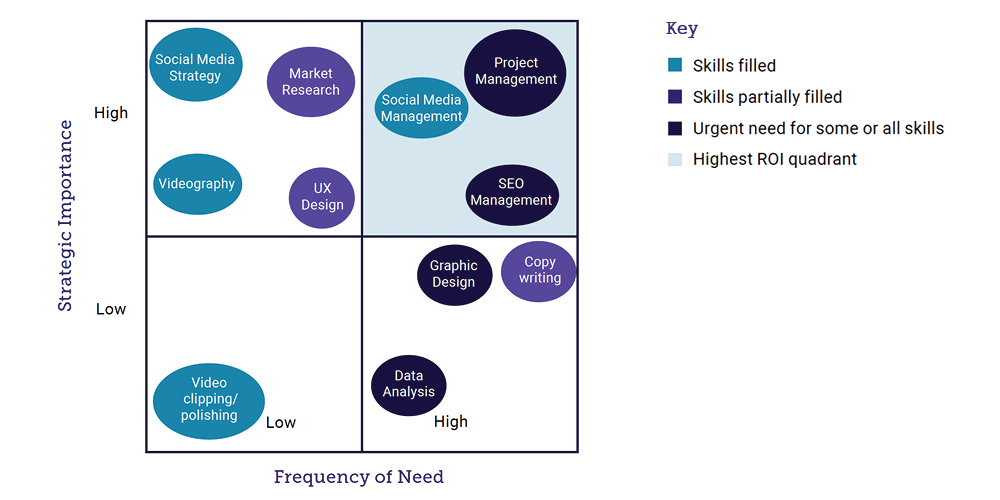Launching your direct sourcing program

This guide is focused on giving you tools that you need to plan and launch a direct sourcing program in your enterprise. We’ll start with your business case, including the all-important skills assessment, and also cover who should be involved in program planning and the planning journey itself. We will then look at what to keep in mind to make progress within the company and the keys to success as your program is rolled out.
GATE

Introduction
In the wake of The Great Realization, many companies see direct sourcing as a smart strategy. The enterprise benefits of a direct sourcing program for the highest-demand and strategic independent talent are compelling.
Here are some of these benefits:
- Hiring managers across the company have access to a centralized repository of vetted and onboarded talent that can be deployed quickly
- Curation of independent professionals with the most strategically important skills helps prevent the churn common when working with staffing agencies (and saves money too)
- A well-defined direct sourcing program is built with compliance in mind, so the risk of misclassification is minimized
- A direct sourcing program is part of an optimized workforce comprised of some portion of full-time employees and independents
We have helped companies across a variety of business sectors to gain business traction through direct sourcing. With proven value and the potential to increase competitive advantage, direct sourcing is likely the way of the future for engaging contingent labor.
Creating a Direct Sourcing Business Case

Of the companies we surveyed for our 2022 contingent labor report, 60% reported using direct sourcing either widely or in some areas of the business, while 28% are running direct sourcing pilots. Over two-thirds of respondents plan to increase their direct sourcing activity over the next year.
Despite the good news about direct sourcing, though, many enterprises still operate traditionally when it comes to contingent labor. In these firms, most if not all independent talent is engaged under the company’s procurement function through managed service providers overseeing hundreds of staffing vendors. Champions of direct sourcing within such firms need to find a way to “move the needle” in favor of this talent strategy. While there are several actions to take, one of the first is to create and gain consensus around a business case.
What Is a Business Case?
A business case provides justification for investing resources in a particular initiative. As a decision-making tool, it describes the proposed journey from the initial idea to the expected outcomes for stakeholders and the business. A well-developed business case is one of the most powerful tools available to business leadership, providing the foundation upon which strategic initiatives rest.
Initially, your business case must answer the key question: Is a direct sourcing initiative worth it? In other words, the purpose of a business case at the outset is to convince key decision-makers of the merits of the strategy. Key elements during decision-making are benefits, costs, and risks.
The second purpose of your business case is to serve as a reference during implementation. As such, it becomes a living document, updated as the initiative proceeds. This requires the inclusion of a timeline with milestones and success metrics tied to key milestones.
Business Case Elements
A direct sourcing business case should include a description of the initiative, the immediate and strategic benefits, the proposed implementation, a cost estimate, a risk assessment, the timeline, and the success metrics associated with key milestones.
We recommend including these elements in your direct sourcing business case:
- Executive summary. To build the executive summary, include key reasons why direct sourcing will save your organization time, enable access to the best talent, and set your organization up for success in the future. Our recent contingent labor report offers key statistics useful to an executive team for this initiative.
- Description of the proposed initiative. Provide an overview of the initiative. What will the initiative achieve? What value will be created for the business? Consider what your organization needs – is it a specific type of talent? Are you trying to save costs? Be considered a Client of Choice? Fill in a specific goal for the coming years? Maintain compliance? All of these can be valid reasons for direct sourcing. Hone in on what matters most to your organization.
- Strategic context: Briefly explain the compelling reasons for the move to direct sourcing. These can include the reasons above, or additional needs specific to your organization.
- Cost projections. Present the estimated costs of the initiative, both to ramp up and to maintain, and describe how it will be funded. Include other resources like people (what role and when) and equipment/system support. Detail is important here as this section can often be one of the first “approval gates” that leaders must pass in their deliberations. It is important to consider which vendor(s) you will use for this project, and you may wish to work collaboratively with them to help build cost projections. A reliable vendor like MBO will be your advocate and transparently help price services throughout the proposal process.
- Timeline. Present the proposed timeline and milestones. This should include the design and deployment period as well as how the static program state will look timewise.
- Expected benefits. List and briefly describe the benefits the organization will receive from the initiative. How long will each benefit take to achieve? Tie benefits clearly to the timeline and be realistic. Though there will likely be benefits at key points in the timeline, most programs will not see all benefits for several months or even years, which means benefits in year one may not have a hard financial return.
- Risks. Decision-makers need to understand the potential risks associated with the initiative. List risks and include possible mitigation measures. This is again a place to involve your vendor and partners. Understand how a migration of independent talent to direct sourcing will take place, and make sure various stakeholders are involved to quell concerns before they derail a project.
- Other options. Discuss other options considered and compare them to the direct sourcing proposition. Prove that this is the best contingent labor talent strategy on which the business can spend resources.
- Success metrics. List the metrics that will be used to measure the state of the initiative. Tie metrics to key milestones during the initial ramp-up and note those that will be used once direct sourcing is implemented.
Business Case Best Practices
Here are some best practices for creating and presenting a well-crafted business case:
- Get stakeholder support before you start. A direct sourcing initiative crosses departments and disciplines. Before you build your business case, discuss the initiative with key stakeholders like IT, HR, and procurement. Better yet, include key stakeholders in the build. This will help achieve critical buy-in and produce a more complete presentation.
- Talk to leadership team members beforehand. The purpose here is two-fold: First, engage with leaders to cultivate relationships with them; second, get a pulse reading about where they stand with respect to direct sourcing (and explain what it is if needed). This will help when you are building the case.
- Accept disagreement. It’s more constructive to engage with leaders or stakeholders who disagree with the strategy than having them sit by nodding their heads (only to find that they do not support you later). Knowing who is not in your camp and why they are holding out can be beneficial. You can provide them with information that addresses their concerns, enroll influencers to win them over, address their issues in your business case—or all three!
- Go for quality over quantity. Steer clear of creating a long business case. While you want to be clear and complete, find ways to do so without much extra verbiage. Use bullet lists where possible and include visuals like graphs and charts to communicate for you.
- Anticipate reactions to your presentation. It’s just not possible to cover everything in detail in your business case, and leadership will have questions and concerns about the initiative. Anticipate the queries and issues that may get raised and prepare your responses well ahead of your presentation. Your key stakeholder partners can be a big help.
- Rehearse your presentation—a lot. Rehearsing will boost your confidence and allow you to be present in the meeting rather than trying to remember the script.
- When you present your case, be clear and concise. Rather than read your business case or slides aloud, let your audience review those on their own. In your presentation, we recommend using this flow: Problem Statement, Current State, Solution, Benefits, and Future State.
- Believe in the initiative. The first person you need to convince is yourself. You must believe that the initiative is the correct strategy for the business, and why. Any doubt or hesitancy in your discussions or presentations can raise questions in people’s minds that could shoot your initiative down.
If you’ve conscientiously built your business case, engaged with leaders and stakeholders beforehand, and delivered a well-thought-through and rehearsed presentation, you should be in a good position to pursue a direct sourcing strategy.
Conducting a Skills Assessment

Obtaining buy-in (and budget) for a direct sourcing program starts with a business case and the business case starts with a hiring report and skills assessment.
Data Collection in 3 Steps
A skills assessment’s goal is identifying the strategic skills essential to achieve your enterprise objectives. These three steps will give you the data needed to create the assessment:
- Make an inventory of all skills hired across your entire workforce (employees and contractors)
- Look at current budgeting and where skills will be needed in the next 30-60-90 + days
- Using your historic and forecast data, you can position skills according to business importance and the frequency of hire
Portraying this information visually can be highly effective. One way to do this is through a Magic Quadrant that places skills relative to strategic importance, frequency of need, and status. This is a simple example for a marketing department.

Preparing the Skills Assessment
With its basis being the data you’ve collected, the skills assessment will be an accurate picture of the current state of the enterprise, the areas where skills are needed, and the recommended distribution of skills across the blended workforce.
The assessment should include:
- Skills ranked strategically (e.g., a number rank with the highest number representing business-critical skills)
- Status of skills in the current talent population (e.g. a green-yellow-red chart that highlights at or above target [green], below-target [yellow] or absent [red] skills)
- Assignment of skills across the workforce (i.e., skills that are best based in the employee population, which are best residing in the contractor community, and which need to be in both)
As the foundation of your direct sourcing business case, this assessment will offer a clear view of where to strategically focus the program. The top right square of the quadrant, representing high importance and frequently hired skills, will produce the highest ROI.
You Don’t Need to Boil the Ocean
Performing a skills assessment across the whole enterprise can be challenging and highly time-consuming. Starting with a business unit, department, or team can be more effective, especially if your business case proposes one or more direct sourcing pilots up front. You’ll get needed data and produce your assessment more quickly—and can use these results to gain traction to create more assessments in the company.
Last Word: Gain Value and Efficiency with a Partner
A highly effective approach to creating your skills assessment is the use of a third-party expert. Such a partner can:
- Help quickly identify needed skills
- Bring experience with other enterprise skill assessments to your initiative
- Facilitate workshops with managers, conduct interviews with leadership, and efficiently review documentation to create your skills inventory
- Help you determine the skills of highest importance and frequency
Make sure the partner you engage understands a skills-based organizational view and has direct sourcing experience in their portfolio. As an outside party who brings insight and best practices to the table, you can gain valuable insight and high-quality results in a timely manner.
Crafting Your Direct Sourcing Strategy

One plus of a direct sourcing program is the ability to engage contractors without going through a third party, which can save costs and improve talent quality. Maintenance of a talent network of independent professionals can improve the re-engagement of high-value talent and minimize contractor churn. This can also increase your organization’s visibility in the market as a Client of Choice for highly skilled workers who only work as independent contractors.
As such, the program must be strategic in nature and focused on skills critical to business success that are best suited to contractors. In short, the business importance and the high repetition of the role being hired will determine where an organization should start its direct sourcing program build-out.
A direct sourcing program does not encompass all independent talent engaged by an enterprise. Rather, it is focused on the most business-critical skills and roles that independent professionals fill. Identifying those skills and roles is part of the early stages of program planning and will define the strategies to pursue.
The process for skill and role identification is data-driven and two-pronged. Your skills assessment will be of valuable assistance.
- Evaluate Your Current Workforce Mix
Gather data for your independent contractors over the past 12 months. Look at the roles and skill areas for which the highest number of contractors were hired. For this group, note the range of billing rates. Create a list that reflects this data.
- Forecast Your Future Workforce Mix
For the second “prong,” canvas managers to find out what skill areas and roles they plan to fill with independent talent in the coming 12 months, along with expected billing rates.
Analyze the current and forecast lists to create the strategic set of skills and roles to consider for inclusion in your direct sourcing program.
Consider a Phased Approach for Your Direct Sourcing Program
It’s not unusual to find that you have an extensive list of independent contractor roles and skills that are of high value to the enterprise. Rather than attempting to include the entire list from the beginning, consider a phased approach.
Locate one or a few business units—teams or departments—that are or will be hiring independents with a subset of the strategic skills. Work with the managers to create and implement a direct sourcing strategy focused on those skills for the business units. At the beginning of your journey, these can serve as pilot initiatives that allow you to test your program and incorporate lessons learned. You can roll out more of our direct sourcing program from there in a phased approach. The managers you work with during the pilots can make a valuable contribution as evangelists, both formally through presentations and informally through word of mouth.
Keep Adjusting Your Direct Sourcing Strategy
The process of gathering data for current and future skills and roles is not a one-and-done exercise. Some companies we’ve worked with have significantly changed in-demand skills needed from their independent talent from one year to the next. To make sure your direct sourcing strategy stays on point, it’s important to monitor how and for what roles independents are being engaged. One way to ensure that you gather needed data periodically is to include the information collection in annual planning activities. This will allow you to make any needed adjustments to your direct sourcing program before the start of the fiscal year.
Tapping Your Direct Sourcing Dream Team

A direct sourcing program is a strategic initiative involving various players. Centered on the talent acquisition function, the initial phase requires design input from other functions in the enterprise. As the program rolls out and matures, most of these functions will participate periodically to provide input, mainly reviewing updates or changes. This multifunctional group is your direct sourcing dream team.
Talent Acquisition
The talent acquisition function is the ideal team captain of your direct sourcing dream team. Given its role in developing long-term talent strategy in partnership with HR, business leaders, and hiring managers, Talent Acquisition is perfectly positioned to focus direct sourcing activity on the skills and roles central to the business. This function can also interface with other team functions to ensure that the required systems and processes are set up and updated.
Talent acquisition is a “hub” in its relationship with other team members. Effective partnerships and interfaces with each function are crucial to moving the program forward.
Procurement
Given that independent talent are officially contractors, procurement is a crucial player on the team. This function ensures that all t’s are crossed, and i’s dotted when it comes to contracts and scopes of work. In close partnership with talent acquisition, the procurement function ensures that needed talent is hired under the proper contract terms with appropriate classification and that they are established and ready to work on day one.
Legal and Finance
Similar to procurement, legal crosses t’s and dots i’s by ensuring that company policies are in place to support the direct sourcing program. Legal needs input into the process to ensure the company and the contractor comply with the firm’s requirements and documentation. Finance is the team member that will help to determine the budgets around the upcoming needs of the business, which will guide the program to areas of success and efficiency when in build-out mode and continued support going forward into business as usual.
Communications and Branding
Program promotion is essential. Within the company, this takes the form of educating hiring managers about the value and use of the program, as well as sharing successes and results. Outside the company, positioning the company as a Client of Choice means communicating the value and benefits that independent professionals can receive by taking on projects that need their skills. Communications and branding assist talent acquisition in crafting messaging for internal audiences and creating external campaigns to attract talent.
IT
Technology plays a significant role in your direct sourcing program. In addition to overseeing the systems that let independent professionals work with the company, IT works with talent acquisition to set up the technological features and capabilities specific to the program.
Executive Sponsor
The last on the team list is actually first in importance to the direct sourcing program. Like any initiative that involves a change in the workplace, having a sponsor in a leadership position is a must. Initially serving as an advocate and evangelist, the sponsor remains briefed on program progress and results.
Delighting the Customer
As the customer base of your direct sourcing dream team, your hiring managers are the beneficiaries of the initiative. While Talent Acquisition proactively partners with them, all of the systems, processes, and workflows your team creates will support the creation of a talent pool of high-value independents with the skills to make a strategic difference to the company.
Planning Your Direct Sourcing Program Journey

The initiative is greenlit, leadership understands the value, and your dream team, comprised of the company functions that need to be involved, is in the know. Before you step onto the path that leads to a successful direct sourcing program, you must plan your route.
It’s important to think through key aspects of implementing your direct sourcing program before putting anything into play. You want clarity around where you want to end up, how you need to proceed to get there, and what will show that you’ve arrived. Also, it’s important to understand how the program will be maintained once it is in place. The first thing you need to do now is to make a roadmap that covers the route, the destination, and the maintenance.
To make the roadmap, set up a planning session with your dream team, probably over a two-day period, that considers questions related to these areas. Though we’re talking here about the initial setup of your direct sourcing program, this activity should take place whenever a major change or expansion is indicated. Creating successive roadmaps will allow your program to evolve in a disciplined manner and capture its history along the way.
Governance
- Who will own the program?
The direct sourcing program, as part of a total talent strategy, ideally belongs to talent acquisition, which may mean moving the management of some independents from procurement. This will take coordination of both functions to determine processes and timing. - What oversight will other dream team members have in their functional areas?
How will the direct sourcing program affect other company functions? Determine what changes may need to take place, if any.
Types of Talent
- Which independent talent will the program focus on?
The direct sourcing program does not encompass all independent talent hired by the company. Thinking in terms of that Magic Quadrant with strategic value (low/high) on the y-axis and skill availability (high-low) on the x-axis. You want to focus on the upper right quarter, that is, low skill availability and high strategic value. Also, take the current and projected contractor hire data you collected for your strategy. These are the roles on which to focus the program so that you can attract, engage, and retain independent professionals who have a high impact on business goals. - How will we identify these people?
Before thinking about external recruitment, consider talent sources closer to home. These could include contractors who have or are currently working with the company, alumni employees, and silver medalists—people who were interviewed for roles but who “just missed” receiving a job offer. Determine how these people will be identified. - How will we source talent in the marketplace?
Discuss how you will recruit your target independent talent in external-facing campaigns.
Projects
- Which projects exist or will be launched that require needed talent?
Gather information from hiring managers about projects that are in-flight or in the pipeline. Which roles will need to be filled?
Managing the Process
- What will the direct sourcing process look like?
Map the steps starting with initial contact and continuing through to onboarding and then to contract completion. But don’t stop there. Discuss how high-value independents can continue their relationship with the company through a talent community.
Timing
- When are the projects identified earlier coming into play?
Discuss where in the project timeline independent talent will be needed. - How long will it take to build the relevant talent pools?
Consider what will be needed to sync this activity with project needs.
Analyzing Results
- Which KPIs and other metrics will be measured?
You will likely set up a set of measurements that are a blend of those used by procurement and talent acquisition. - How frequently will metrics be gathered?
Agree on the frequency of measurement. Different metrics may have different timings.
Learning to Enhance the Program
- How will the results be translated into program adjustments and improvements?
As much as possible, codify how results will contribute to learning and how what you learn will be applied to the program.
Making Progress with Managers

Achieving the business benefits of an effective direct sourcing program requires some adjustments within the enterprise in terms of how it relates to independent professionals. To support your success, it’s important that hiring managers understand the viewpoints of high-value independent talent.
As the independent portion of the workforce continues to grow, its members—as business owners—are interested in more than pay rates. They want to grow their businesses, honing existing skills and learning new ones in order to expand their markets. They seek meaningful and interesting work with clients who align with their values. Many are focused on cultivating a portfolio of Clients of Choice, companies where they can contribute more over time as they gain a better understanding of management goals and strategies.
Targeting, attracting, engaging, and curating high-value independents for your direct sourcing program requires a level of understanding among line and hiring managers. Here are three areas where improving understanding can strengthen and grow your program:
- The difference between using a staffing agency and direct sourcing. Direct sourcing brings the recruiting and vetting of independent candidates in-house. Once high-quality talent has been onboarded, getting them in for future projects is quick and easy. And calling on independent professionals who know the company, know the roles they fill, and understand the organization’s culture will be able to hit the ground running. Selling benefits like these can motivate hiring managers to adjust (if needed) their resource planning.
- How to keep independent candidates warm. An example of a resource planning adjustment, based on our experience working with MBO client companies, is thinking ahead about skills that will (or may) be needed in a month, two months, or a quarter and keeping the direct sourcing team—your procurement and HR teams, for example—informed about projected needs. In turn, the direct sourcing team can let talent network members know about future opportunities and the anticipated timing. This can keep members engaged and help ensure that preferred candidates are available when the role is there.
- How to effectively segment messaging within your talent network. It is highly likely that the talent in your direct sourcing program will be monolithic in terms of the level of knowledge and expertise. For example, the content and approach you take with a senior-level independent who has been in their own business for several years will differ from how you communicate with less experienced talent or those new to solo business ownership. This is where marketing can assist HR (if needed) to create communications that are of value to each of your audiences within the talent network.
Achieving understanding in these three areas will be a giant step in the direction of a successful, effective direct sourcing program.
Keys to a Successful Program

So far we’ve considered the baseline elements of your direct sourcing program. Let’s look at some of these from another angle and in additional depth.
Brand Strategy
Your goal is to be the Client of Choice for independent professionals whose skills and experience are of high strategic value to your enterprise. How will you attract those people? The brand strategy of your direct sourcing program is a hybrid of marketing and talent acquisition. On the marketing side, you want to promote the benefits of engaging with your company by answering “What’s in it for me?”—how their work with you will help independents grow their own businesses. On the talent acquisition side, you want to promote company culture, the quality of the work they will do, and the kinds of opportunities that are available and need their skillsets. Tap these members of your dream team to help brainstorm the right branding strategy.
Current Talent Migration
You aren’t starting from scratch in terms of the independent talent your direct sourcing program targets. Many hiring managers throughout the enterprise will have “prized” independents they have engaged in the past or who are currently working for them. Contractors like these, employee alumni, and “silver medal winners”—job applicants that just missed the job offer—are examples of groups where high-value talent already resides. Live test the branding strategy by inviting these professionals into your talent network as the first members of the direct sourcing program.
New Talent Sourcing
Take that branding strategy out into the world through well-executed campaigns that reach the independent talent you are targeting. While some of your campaign messaging can be general—attractive to any of your target independents—focus some of your messaging to attract specific skill areas. Speak their language, appeal to the interests, expertise, and goals of those particular worker subsets. Communicate the advantages of being part of your talent network and make it easy for independent professionals to get more information, express interest, and join your talent network.
Ongoing Support
As your direct sourcing program takes root and your talent network grows, stay connected. Reach out to hiring managers to anticipate their needs and curate qualified talent. Leverage online communication platforms to foster conversations. Elicit feedback from company managers and independent professionals on a regular basis. Use this feedback along with the KPI metrics you track to make adjustments that work for all involved.
Your ability to attract and retain independent talent of high value to the enterprise is a key success factor for your direct sourcing program. As a Client of Choice for the talent that can produce outcomes aligned with enterprise strategies, your enterprise will have a strong market position on a steady growth path.
In this guide
Subscribe to the Insights blog to get weekly insights on the next way of working
Related posts
Learn more about MBO
Learn how to start, run and grow your business with expert insights from MBO Partners
Learn how to find, manage and retain top independent contractors for your projects.
MBO Partners publishes influential reports, cited by government and other major media outlets.
Research and tools designed to uncover insights and develop groundbreaking solutions.


